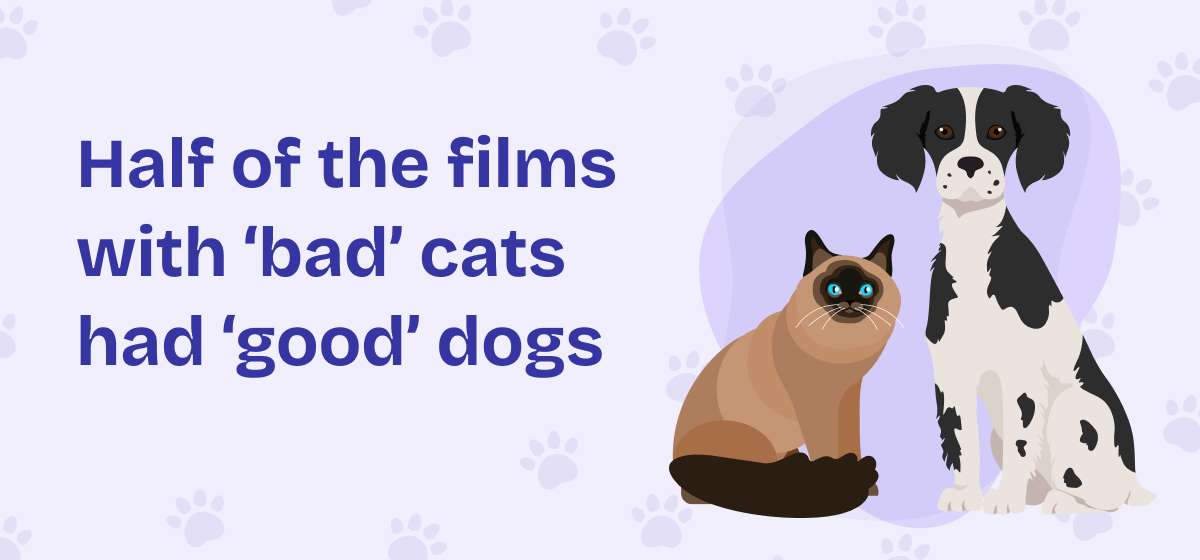Paws & Prejudice: A Study of Anti-Cat Bias in TV & Film
Why are so many people anti-cat? New data from Evoluted’s digital PR team reveals the answer may lie in the film and TV we consume.

We all know dogs are a man’s best friend, but what’s a cat’s role in our lives? Dogs are universally loved worldwide whereas cats are met with more disdain than their canine counterparts.
The Evoluted team wanted to explore why that was the case and questioned whether the media we consume was the reason for the anti-cat bias. After all, they can be just as cute, friendly and affectionate as a pooch.
With that in mind, the Evoluted digital PR team has analysed how cats are portrayed on the silver screen. In this study, we analysed TV and film data to explore the representation of cats in the media. We found:
- 64% of cats in TV and 60% of cats in film were portrayed negatively
- Animations were the worst for negative cat representation
- Persian and black cats were most commonly portrayed as the villains, but ginger cats had the best portrayal
What do Brits think about cats?
In terms of representation, according to the PDSA, 29% of UK adults own a dog - this equates to an estimated population of 11 million pet dogs. Although slightly lower, nearly a quarter (24%) of the UK have a cat - this roughly equates to a population of 11 million pet cats, as most cat owners adopt more than one cat per household.
YouGov asked UK residents whether or not they were a dog or cat person and among Britons generally, including those without pets, they found 48 per cent thought themselves more of a dog person while 30 per cent preferred cats.
Not a cat ‘purr’son? The study reveals you could have been influenced by the TV and films you’ve watched.
Top 50 Cats in Films
60% of cats have mixed or negative representation - in over half cats were ‘baddies’
In this silver screen deep dive we explore how cats have been perceived in the media. Starting with film, we found cats have often played a prominent yet misunderstood role, with 60% of them being typecast as an unremarkable character or, more often, a tyrant.

By conducting thorough research, the PR team at Evoluted meticulously examined how cats are portrayed in the media. We delved into popular films using sources like IMDB, Wikipedia, and Cats in Cinema, identifying the 100 most prominent feline characters. From this list, the top 50 cats were screened to analyse primary themes and detect any anti-cat sentiment.
Across the films, cats generally had an unsavoury portrayal - especially in films where cats had a role alongside a dog. The concept of ‘Cats vs. Dogs’ is a great example of how cats are often typecast as a villain and dogs are blessed with hero status. Similarly, in many of the films that were made for children, cats were represented negatively.
Despite these stereotypes, there's a handful of iconic feline performances that have not only challenged conventions but also left a paw-sitive mark on cinematic history. For instance, ‘Cat’s’ role in Breakfast at Tiffany’s is profound as the character’s loveable role mirrors Holly Golighty’s.
Why is the media anti-cat? Pet psychologist reveals all
Dr. Jeremy Campbell, Clinical Director at The London Cat Clinic who has a BVSc in Feline Medicine, says cats’ negative portrayal may derive from their generally subtle nature.
He said: “Cats are not obvious with their emotions and don't provide the immediate gratification that dogs do and so are perceived as unfriendly or unemotive.”
Dr Campbell explains dogs are more emotive with their adoration, but cats will show their love once they have the measure of a person and their impact on their environment and feeling of being safe.
He said: “[Cats] need time to assess their environment and the people in it, make an assessment and then interact or react accordingly. If you rush at a cat she is going to run away as she perceives you are a threat. Which in all honesty I would as well! If you sit quietly, remain aware of feline body language and behavioural requirements and offer a finger for the feline to sniff and familiarise you, you will be amazed at what this brings.”
The negative representation of cats is not accurate, according to the cat expert, as cats are often as loving as dogs, they usually just need more time to review a person and an environment.
He added: “Once a cat knows you and trusts you they are as trainable as dogs, if you desire this. In my opinion, cats bring a level of intelligent love and empathy that far exceeds their canine counterparts.”
Persian & Siamese cats had the worst representation of all pedigree breeds

Of the ‘bad’ film cats, over 1 in 6 were Persian (16%) and 1 in 8 (12%) were Siamese cats.
An intriguing trend emerges when examining the roles of ‘good’ and ‘bad’ cats in films. These stats highlight the anti-cat bias towards certain cat breeds, raising questions about the reasons behind such casting choices.
Siamese cats, known for their striking blue eyes and vocal nature, have often been portrayed as cunning or mysterious in cinematic narratives. On the other hand, Persian cats, with their luxurious long fur and calm demeanour, might seem an unusual choice for 'bad' characters, yet their appearance in these roles suggests a deliberate selection by filmmakers.
This film pattern underscores the complex relationship between breed stereotypes and their representation in film, prompting further exploration into how these choices influence our perception of cats both on and off the screen.
Interestingly, feline expert Dr. Jeremy Campbell said Persian cats could be placed in these villainous roles because of a concept called anthropomorphism. This term refers to when human characteristics are attributed to an animal.
He said: “Persians possess particularly neotenous features so they are labelled more frequently with human emotions like being 'grumpy or angry' as parallels are drawn from humans when this simply isn't the case.”
Nearly half of the films’ cat villains were black or grey

Of the 'villainous' cats in films, 44% of the felines donned darker-coloured fur, primarily black or grey. Among this group, nearly a third were black cats.
Using dark-furred feline antagonists raises questions about the symbolism and stereotypes associated with these cats. Black cats, in particular, have long been linked with superstitions and folklore, often cast as omens of bad luck or witches' familiars. This association has persisted through the ages and is mirrored in their frequent portrayal as antagonists on TV and film. Dr. Campbell agrees, he says the villainous depiction of cats in media is linked to mythology.
Ginger cats had the most positive film representation
Nearly half (45%) of the ‘good’ cats were ginger
Ginger cats emerge as the silver screen's most positively represented feline stars, with nearly half (45%) of the 'good' cats donning a distinctive orange coat. This intriguing trend highlights the endearing qualities often associated with ginger cats, such as their friendly and affectionate nature, which filmmakers have leveraged to create beloved and relatable characters.
In contrast, tabby cats are charming in their own right, with 1 in 6 (15%) portraying the 'good' cats in films.
Half of the films with ‘bad’ cats had ‘good’ dogs

In around half of the films that featured ‘bad’ cats, dogs also shared the limelight. However, unlike the unappealing representation of cats, a huge 85% of these dog characters, a total of 11 out of 13 instances, were cast as the 'heroes' or had positive representation in these movies.
This trend shows the classic cinematic rivalry between cats and dogs, where dogs often take on the role of loyal protectors while cats are portrayed as aloof and standoffish.
Top 50 Cats in TV
Two-thirds of TV cats had bad or mixed representation
The representation of the most recognised cats in TV is even worse on the small screen as two-thirds (64%) of cats face negative or mixed portrayals.

By examining IMDB's top 100 feline characters in popular TV shows, we selected the top 50 that played the most pivotal roles in the episodes, subjecting them to detailed analysis. Through conducting extensive research, the PR team at Evoluted scrutinised how cats are depicted in the media, to reveal recurring patterns and general anti-cat biases.
While some cats might play the role of lovable companions, the overwhelming majority were cast as mischievous troublemakers like T.C in Top Cat, forgotten or less regarded pets like Snowball in The Simpsons or even outright villains like White Kitty in Powerpuff Girls.
The data looks at cats like Bagpuss who had the starring role, along with the popular TV shows where cats had a prominent role in an episode - like when Rachel adopts a Sphynx cat in the Friends episode ‘The One with the Ball.’
Animations were the worst for negative cat representation
Closely followed by comedy
Animation was the genre of show where cats had the most prominent TV roles. Coincidentally, this was the genre which had the most negative portrayal of cats - 84% of bad cats were featured in animations and 31% were featured in comedies.
As animations often rely on stereotypes to appeal to children and create memorable characters, cats may often be portrayed negatively for comedic effect.
These simplistic character dynamics may be used to convey moral lessons which can lead to the vilification of certain characters, including cats.
Seeing cats in this negative light at a young age may influence a person’s initial perception on cats and what they expect their behaviour to be like. This could be why dogs took a higher percentage of the vote in YouGov’s dog vs. cat person debate.
USA had the worst cat representation & Russia had the most positive representation of cats
Of the two Russian shows which featured in IMDB’s top shows that feature cats, both had a positive portrayal of the feline protagonists, showing that Russia was the country that had the most favourable view of cats.
Conclusion
By analysing data sources for cats who had prominent roles in TV programmes and films, this report sheds light on the impact the media may have had on our perception of cats.
It found factors such as genre and country of origin ultimately affected how a cat was perceived on the silver screen. In addition, in films and TV shows where there were both cats and dogs, dogs had an overwhelmingly positive representation, compared to cats.
Like all stereotypes and tropes though, few are accurate. Instead cats, like dogs, should be regarded in their own individual right.
Methodology:
Through research, the PR team at Evoluted analysed the representation of cats in the media to uncover running themes and anti-cat sentiment.
For TV - The team analysed IMDB’s top 100 cats in popular TV shows and screened the top 50 that had the most pivotal role in the show/episodes.
For Film - The team used IMDB, Wikipedia and Cats in Cinema to see the 100 most popular cats in film and screened the top 50 with the most screen time.
Our talented Digital PR team is focused on developing creative, results-driven digital PR campaigns and activity to help you boost search visibility and brand awareness. If you think we can help you, get in touch today.







